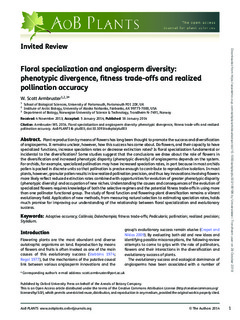| dc.contributor.author | Armbruster, William Scott | |
| dc.date.accessioned | 2019-10-31T11:48:08Z | |
| dc.date.available | 2019-10-31T11:48:08Z | |
| dc.date.created | 2015-01-20T08:42:01Z | |
| dc.date.issued | 2014 | |
| dc.identifier.citation | AoB Plants. 2014, 6. | nb_NO |
| dc.identifier.issn | 2041-2851 | |
| dc.identifier.uri | http://hdl.handle.net/11250/2625577 | |
| dc.description.abstract | Plant reproduction by means of flowers has long been thought to promote the success and diversification of angiosperms. It remains unclear, however, how this success has come about. Do flowers, and their capacity to have specialized functions, increase speciation rates or decrease extinction rates? Is floral specialization fundamental or incidental to the diversification? Some studies suggest that the conclusions we draw about the role of flowers in the diversification and increased phenotypic disparity (phenotypic diversity) of angiosperms depends on the system. For orchids, for example, specialized pollination may have increased speciation rates, in part because in most orchids pollen is packed in discrete units so that pollination is precise enough to contribute to reproductive isolation. In most plants, however, granular pollen results in low realized pollination precision, and thus key innovations involving flowers more likely reflect reduced extinction rates combined with opportunities for evolution of greater phenotypic disparity (phenotypic diversity) and occupation of new niches. Understanding the causes and consequences of the evolution of specialized flowers requires knowledge of both the selective regimes and the potential fitness trade-offs in using more than one pollinator functional group. The study of floral function and flowering-plant diversification remains a vibrant evolutionary field. Application of new methods, from measuring natural selection to estimating speciation rates, holds much promise for improving our understanding of the relationship between floral specialization and evolutionary success. | nb_NO |
| dc.language.iso | eng | nb_NO |
| dc.publisher | Oxford Academic | nb_NO |
| dc.rights | Navngivelse 4.0 Internasjonal | * |
| dc.rights.uri | http://creativecommons.org/licenses/by/4.0/deed.no | * |
| dc.title | Floral specialization and angiosperm diversity: phenotypic divergence, fitness trade-offs and realized pollination accuracy | nb_NO |
| dc.type | Journal article | nb_NO |
| dc.type | Peer reviewed | nb_NO |
| dc.description.version | publishedVersion | nb_NO |
| dc.source.pagenumber | 24 | nb_NO |
| dc.source.volume | 6 | nb_NO |
| dc.source.journal | AoB Plants | nb_NO |
| dc.identifier.doi | 10.1093/aobpla/plu003 | |
| dc.identifier.cristin | 1201829 | |
| dc.description.localcode | This is an open access article distributed under the terms of the Creative Commons CC BY license, which permits unrestricted use, distribution, and reproduction in any medium, provided the original work is properly cited. You are not required to obtain permission to reuse this article. | nb_NO |
| cristin.unitcode | 194,66,10,0 | |
| cristin.unitname | Institutt for biologi | |
| cristin.ispublished | true | |
| cristin.fulltext | original | |
| cristin.qualitycode | 1 | |

